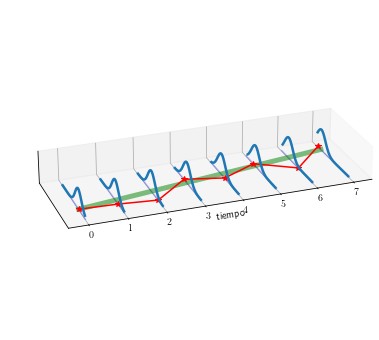Ilustrando la diferencia entre serie de tiempo y proceso estocástico, estacionario y no estacionario
Contents
1.3. Ilustrando la diferencia entre serie de tiempo y proceso estocástico, estacionario y no estacionario#
from mpl_toolkits import mplot3d
import matplotlib.pyplot as plt
import numpy as np
from matplotlib import rc
rc('text', usetex=True)
figpath = "../figures/"
Crear los datos#
t = np.arange(0, 8)
y = np.arange(-9, 9, 0.125)
T, Y = np.meshgrid(t, y)
Definir funciones para graficar las funciones de densidad de probabilidad (pdf)#
def pdf(x,mu,sigma):
return np.exp(-(x-mu)**2/(2*sigma**2)) / (sigma*np.sqrt(2*np.pi))
def pdf_plot(x,mu,sigma, ax, fname):
Z = pdf(x, mu, sigma)
for ti in T[0]:
ax.plot([ti, ti],[x.min(), x.max()], 0, 'blue', alpha=0.25)
ax.plot(T[0], mu[0], 0,'red', alpha=0.5, linewidth=5)
surf = ax.plot_wireframe(T, Y, Z, rstride=0, cstride=1, linewidth=2.5)
ax.set(xlabel='\ntiempo',
ylabel=' ',
ylim=[-10,10],
zlim=[0,0.5],
yticks=[],
zticks=[]
)
ax.set_box_aspect((18,6,2))
ax.view_init(25, 250)
plt.gcf().patch.set_facecolor("None")
plt.savefig(figpath + fname,bbox_inches='tight')
Graficar las funciones#
common_figure_size = [8,8]
fig = plt.figure(figsize=common_figure_size)
ax1 = plt.axes(projection='3d')
pdf_plot(Y, 0*T, 1.5, ax1,'stationary.pdf')
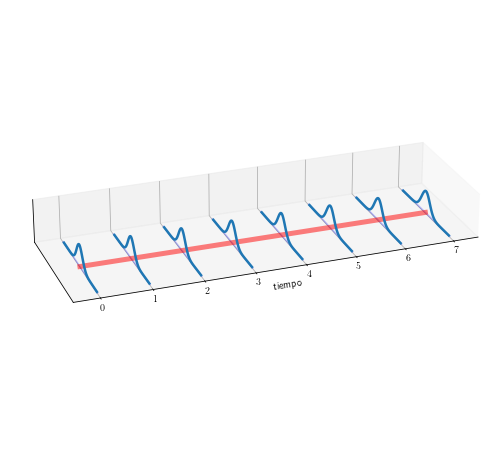
fig = plt.figure(figsize=common_figure_size)
ax2 = plt.axes(projection='3d')
pdf_plot(Y, 1.2*T-4, 0.85, ax2,'trending.pdf')
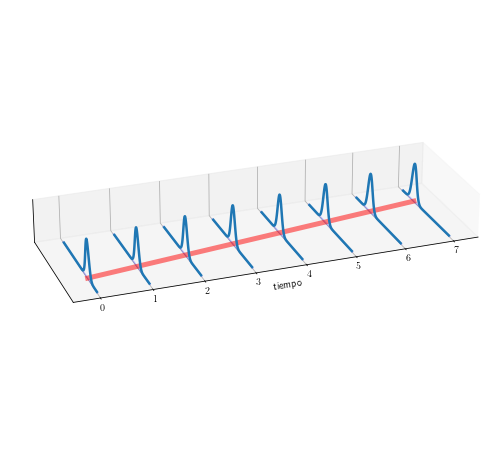
fig = plt.figure(figsize=common_figure_size)
ax3 = plt.axes(projection='3d')
pdf_plot(Y, 0*T, (T+2)**0.5/2, ax3,'widening.pdf')
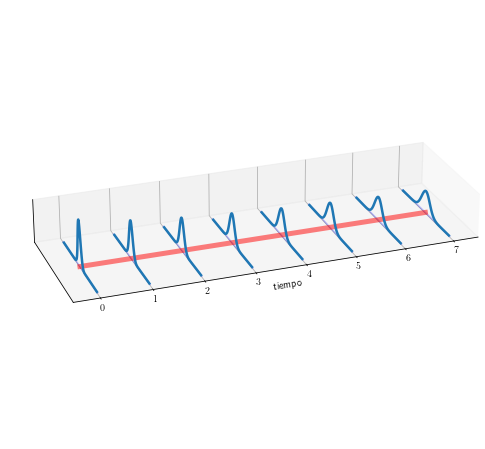
Simular muestras tomadas de estas distribuciones#
def pdf_plot_muestra(x,mu,sigma, fname):
fig = plt.figure(figsize=[9,6])
ax = plt.axes(projection='3d')
Z = pdf(x, mu, sigma)
for ti in T[0]:
ax.plot([ti, ti],[x.min(), x.max()], 0, 'blue', alpha=0.25)
ax.plot(T[0], mu[0], 0,'green', alpha=0.5, linewidth=5)
sample = mu[0] + sigma[0]*np.random.randn(*mu[0].shape)
ax.set_box_aspect((18,6,2))
elev = 25.0
azim = 250.0
ax.view_init(elev, azim)
ax.plot(T[0], sample, 'r-*')
surf = ax.plot_wireframe(T, Y, Z, rstride=0, cstride=1, linewidth=2.5)
ax.set(xlabel='tiempo',
ylabel=' ',
ylim=[-11,11],
yticks=[ ],
zlim=[0,0.25],
zticks=[])
fig.set_size_inches([9,6])
fig2, ax2 = plt.subplots(figsize=[9,2])
ax2.plot(T[0], mu[0],'green', alpha=0.25, linewidth=5)
ax2.plot(T[0], sample, 'r-*')
ax2.set_xlabel('tiempo')
ax2.set_ylabel('y')
ax2.spines['right'].set_visible(False)
ax2.spines['top'].set_visible(False)
fig.patch.set_facecolor("None")
fig2.patch.set_facecolor("None")
fig.savefig(figpath+fname+'-3D.pdf',bbox_inches='tight')
fig2.savefig(figpath+fname+'-2D.pdf',bbox_inches='tight')
return None
pdf_plot_muestra(Y, 0*T, 2.4*np.ones_like(T), 'serie-estacionaria')
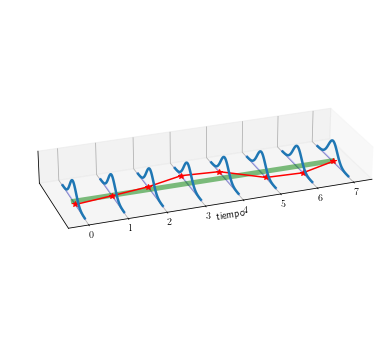

pdf_plot_muestra(Y, 1.5*T-4, 2.4*np.ones_like(T), 'serie-no-estacionaria')
